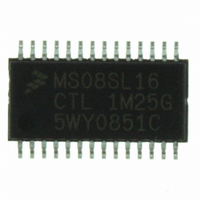MC9S08SL16CTL Freescale Semiconductor, MC9S08SL16CTL Datasheet - Page 331

MC9S08SL16CTL
Manufacturer Part Number
MC9S08SL16CTL
Description
MCU 16KB FLASH SLIC 28TSSOP
Manufacturer
Freescale Semiconductor
Series
HCS08r
Datasheet
1.DEMO9S08EL32.pdf
(356 pages)
Specifications of MC9S08SL16CTL
Core Processor
HCS08
Core Size
8-Bit
Speed
40MHz
Connectivity
I²C, LIN, SCI, SPI
Peripherals
LVD, POR, PWM, WDT
Number Of I /o
22
Program Memory Size
16KB (16K x 8)
Program Memory Type
FLASH
Eeprom Size
256 x 8
Ram Size
512 x 8
Voltage - Supply (vcc/vdd)
2.7 V ~ 5.5 V
Data Converters
A/D 16x10b
Oscillator Type
External
Operating Temperature
-40°C ~ 85°C
Package / Case
28-TSSOP
Processor Series
S08SL
Core
HCS08
Data Bus Width
8 bit
Data Ram Size
512 B
Interface Type
I2C/SCI/SPI
Maximum Clock Frequency
40 MHz
Number Of Programmable I/os
22
Number Of Timers
6
Operating Supply Voltage
5.5 V
Maximum Operating Temperature
+ 85 C
Mounting Style
SMD/SMT
3rd Party Development Tools
EWS08
Development Tools By Supplier
DEMO9S08EL32, DEMO9S08EL32AUTO
Minimum Operating Temperature
- 40 C
On-chip Adc
16-ch x 10-bit
Package
28TSSOP
Family Name
HCS08
Maximum Speed
40 MHz
For Use With
DEMO9S08EL32 - BOARD DEMO FOR 9S08 EL MCUDEMO9S08EL32AUTO - DEMO BOARD EL32 AUTO
Lead Free Status / RoHS Status
Lead free / RoHS Compliant
Available stocks
Company
Part Number
Manufacturer
Quantity
Price
Company:
Part Number:
MC9S08SL16CTL
Manufacturer:
Freescale
Quantity:
2 359
- Current page: 331 of 356
- Download datasheet (9Mb)
The average chip-junction temperature (T
where:
For most applications, P
(if P
Solving
where K is a constant pertaining to the particular part. K can be determined from equation 3 by measuring
P
solving
A.5
Although damage from electrostatic discharge (ESD) is much less common on these devices than on early
CMOS circuits, normal handling precautions should be used to avoid exposure to static discharge.
Qualification tests are performed to ensure that these devices can withstand exposure to reasonable levels
of static without suffering any permanent damage.
All ESD testing is in conformity with AEC-Q100 Stress Test Qualification for Automotive Grade
Integrated Circuits. During the device qualification ESD stresses were performed for the human body
model (HBM) and the charge device model (CDM).
A device is defined as a failure if after exposure to ESD pulses the device no longer meets the device
specification. Complete DC parametric and functional testing is performed per the applicable device
specification at room temperature followed by hot temperature, unless specified otherwise in the device
specification.
Freescale Semiconductor
D
(at equilibrium) for a known T
I/O
T
θ
P
P
P
JA
D
int
I/O
A
1
2
is neglected) is:
Equation A-1
= Ambient temperature, °C
= P
Equation A-1
= Package thermal resistance, junction-to-ambient, °C/W
= I
Junction temperature is a function of die size, on-chip power dissipation, package thermal resistance,
mounting site (board) temperature, ambient temperature, air flow, power dissipation of other components on
the board, and board thermal resistance.
Junction to Ambient Natural Convection
= Power dissipation on input and output pins — user determined
ESD Protection and Latch-Up Immunity
int
DD
+ P
× V
I/O
DD
, Watts — chip internal power
and
and
I/O
MC9S08EL32 Series and MC9S08SL16 Series Data Sheet, Rev. 3
Equation A-2
Equation A-2
<< P
K = P
int
A
and can be neglected. An approximate relationship between P
. Using this value of K, the values of P
D
P
T
× (T
D
J
iteratively for any value of T
for K gives:
= K ÷ (T
= T
J
A
) in °C can be obtained from:
+ 273°C) + θ
A
+ (P
J
D
+ 273°C)
× θ
JA
JA
)
× (P
D
)
2
A
.
D
Appendix A Electrical Characteristics
and T
J
can be obtained by
D
Eqn. A-1
Eqn. A-2
Eqn. A-3
and T
333
J
Related parts for MC9S08SL16CTL
Image
Part Number
Description
Manufacturer
Datasheet
Request
R
Part Number:
Description:
Manufacturer:
Freescale Semiconductor, Inc
Datasheet:
Part Number:
Description:
Manufacturer:
Freescale Semiconductor, Inc
Datasheet:
Part Number:
Description:
Manufacturer:
Freescale Semiconductor, Inc
Datasheet:
Part Number:
Description:
Manufacturer:
Freescale Semiconductor, Inc
Datasheet:
Part Number:
Description:
Manufacturer:
Freescale Semiconductor, Inc
Datasheet:
Part Number:
Description:
Manufacturer:
Freescale Semiconductor, Inc
Datasheet:
Part Number:
Description:
Manufacturer:
Freescale Semiconductor, Inc
Datasheet:
Part Number:
Description:
Manufacturer:
Freescale Semiconductor, Inc
Datasheet:
Part Number:
Description:
Manufacturer:
Freescale Semiconductor, Inc
Datasheet:
Part Number:
Description:
Manufacturer:
Freescale Semiconductor, Inc
Datasheet:
Part Number:
Description:
Manufacturer:
Freescale Semiconductor, Inc
Datasheet:
Part Number:
Description:
Manufacturer:
Freescale Semiconductor, Inc
Datasheet:
Part Number:
Description:
Manufacturer:
Freescale Semiconductor, Inc
Datasheet:
Part Number:
Description:
Manufacturer:
Freescale Semiconductor, Inc
Datasheet:
Part Number:
Description:
Manufacturer:
Freescale Semiconductor, Inc
Datasheet:











